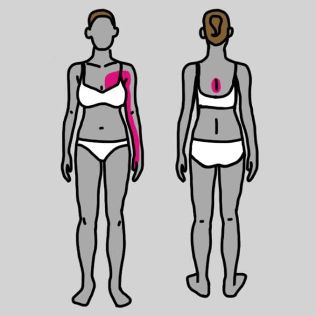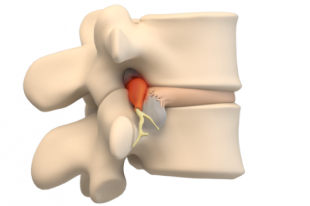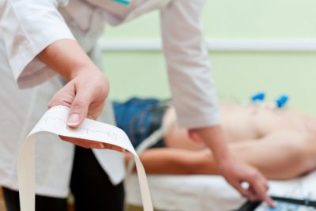The attacks of pain, without the exact location is always terrible. Especially if it is poured into the left side of the body, covering the hand and even foot. In most cases, cannot without the assistance of a doctor.

It's hard to explain to family or colleagues, it hurts the whole left side, and not to be considered a malingerer. Even doctors sometimes spend more than one examination to identify the causes. However, these symptoms should not be ignored. After all, at the same time pain in the left upper quadrant, hands and even feet can be a harbinger of stroke, heart attack and other critical illnesses.
Problems with the spine
On the left side of the body can be damaged in trauma. This source of discomfort is obvious. In other cases, first survey carried out in two directions: to analyse the status of the heart and spine. Due to diseases of the musculoskeletal system often manifests other pain, left with an unclear localization.
Osteochondrosis
When the blood circulation in the tissues of the spine, the intervertebral disks become less elastic, fibrous ring is gradually destroyed, mainly of the nerve roots. This leads to a number of factors:
- a sedentary lifestyle;
- hard physical work;
- age changes of the body;
- endocrine diseases.
The result of the right or left side of the back, neck, lower back start to hurt. Changes the sensitivity of other parts of the body. In the localization of unpleasant sensations associated with the location of destructive-dystrophic process. So, with cervical osteochondrosis often occurs pain in my left shoulder, arm, numbness of the fingers and the outer edge of the palm of the hand. They arise when the lumbar backache, dragging pain, paresthesia in the corresponding part of the back, hips and legs.
Sciatica

Due to the narrowing of the distance between the clamped vertebrae and inflammation of nerve fibers that extends from the spinal cord. This complication of degenerative disk disease, which is called sciatica. As an independent pathology occurs as a response to a failed sudden movement, hypothermia, back injury back muscles.
Cervical-brachial form sends the pain over the upper quarter of the body: shoulder blades, neck, hands. Radiculopathy lumbar-sacral-sciatica affects the sciatic nerve. There is pain in the left hip, butt cheek, spreading down the leg to the heel. In the initial phase can be complaints about "tracking" the lower part of the leg, and the feeling of shivers.
You cannot start this disease. This destroyed disk cannot be recovered. After the removal of pain syndrome and acute inflammation, the only reliable way to keep the disease remains prevention. This includes mandatory physiotherapy, posture, control, a healthy way of life. Help regular therapy, body to body massage, to improve circulation in the area of the affected vertebrae.
Intercostal neuralgia
A painful, burning sensation or sharp pain in the left side – not necessarily the heart of the problem. This could be intercostal neuralgia. But the symptoms are quite similar:
- the pain comes suddenly after a slight movement of the body;
- the entire left side of the chest may turn pale or blush;
- the sensations radiating under the shoulder blade and lower back;
- increased sweating;
- notice burning, loss of sensation in certain parts of the body;
- take a deep breath, sneezing, coughing increase the severity of the symptom.
All of this happens due to damage of nerve fibres in the intercostal region. Causes irritation, associated with hypothermia, stagnation of blood, injury, poisoning, complications of infectious diseases or the degenerative disk disease. Usually influenced by a range of factors, including fatigue and reduced resistance.
The main symptoms that help to distinguish neuralgia from the pain of the heart.
- The irritation of the intercostal receptors of sensations do not disappear from having nitroglycerin, but is weakening under the effect of sedatives (validol, Corvalol).
- In angina attacks are usually short, and pain in the left side and under the shoulder – compression, aggravated by exertion. In neuralgia, the entire upper part of the body can hurt more than one day, the answer for every movement.
- When palpation of the chest or the back stand out a sore point between the ribs, near the spine.
The main method of treatment of neuralgia – the elimination of the causes that cause irritation to the nerves. Identify only the neurologist after a series of tests. Due to the disease is to be distinguished from renal colic, angina, sciatica.
Cardiac pathology

Complaints of the heart, pain in the left hypochondrium, which gives to the shoulder, arm, neck, jaw, which are not always associated with coronary heart disease and angina pectoris. Similar symptoms are observed cardialgia due to inflammation of the heart muscle (myocarditis) or the destruction of the heart membrane (pericarditis). These diseases occur as complications of colds, flu, pneumonia, and other infectious diseases.
If the disease do not manifest themselves in the initial stages, it can develop almost asymptomatic. When myocarditis see:
- fatigue;
- heart palpitations;
- shortness of breath and mild pain after the minor load;
- later joined by dizziness;
- swelling of the lower extremities.
Pericarditis rarely occurs as an independent disease. About this report
- pain when the body is tilted forward, lying on left side;
- different force sensation in the chest, which is transmitted to the back, arms, lower back;
- fast, irregular, weak pulse;
- cough without sputum;
- skin whitening;
- some lividity of the body (especially hands and feet).
Early detection and timely treatment of heart disease, reduces the risk of heart attack. Recurrent pain in the left hypochondrium and the region of the heart, to come into the doctor's office. For the diagnosis ECG and EchoCG. With their help identify heart rhythm abnormalities, reveal the size of the heart chambers, the presence of fluid in the bag. X-rays show tumors, diseases of the ribs and lungs.
Stroke
Before the stroke, pain in the body and the limbs is rare. On the contrary, on the one side of the body may lose sensitivity. However, if the damage to the brain in the region of the optic thalamus develops post-stroke pain in the left or right along the body – thalamic syndrome. Additional features:
- pain from bright light, movement, emotions;
- sensing the temperature;
- the single type of stimuli seems to be more;
- often accompanied by tingling and decreased sensitivity of the skin.
The thalamus is the largest center of pain sensitivity. Causes symptoms due to lack of oxygen in tissues due to impaired blood flow. Pain in left side extremities and occurs when the lesion in the opposite side of the brain. However, after the strokes can hurt one side of the body, even if is affected natallichka structure. In addition to the Central neuropathic pain may experience pain and muscle spasms.

To combat the painful effects of strokes prescribed by the concomitant use of antidepressants and anticonvulsants. Muscle pain, relieve muscle relaxants, massage, special exercises, physical therapy.
What has been the result of unilateral pain in the left hypochondrium, thigh, arms and other, the self-test will not be able to identify its exact cause. 3 hours prior to the visit in the clinic is recommended, to refrain from taking pain medication, sedatives. And in the case of acute deterioration requiring emergency medical care.





































